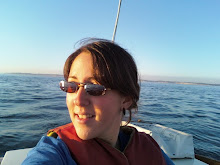After performing a necropsy on the 70 foot female fin whale hit by a Princess Lines cruise ship last week, it was discovered that the whale had a thin layer of blubber and no food in her stomach. While this could be due to the whale having offspring, and therefore a thinner layer of blubber, it was unlikely that the mature whale was reproducing at her age.
There is no word on whether or not the whale was dead when hit, but that information may come out after more tests are done in the next several weeks.
Friday, July 31, 2009
Monday, July 27, 2009
Bet You've Never Seen This on a Cruise
A Princess Lines Cruise Ship pulled into Canada Place in Vancouver, B.C. last week. Unbeknown to them, they had an additional passenger. Well, can you call a 70-foot long fin whale a passenger if it's not on board? Sometime during the night the ship struck the whale and took it all the way in to the Vancouver harbor.
Chances are, the fin whale was either dead already or killed on impact -- a strike like that would probably break it's back -- but the whale has been taken to Canada's Department of Fisheries and Oceans in Sidney for a necropsy. After the scientists determine whether the whale was dead or alive when hit, they will sink it off the west coast of Vancouver Island so that it can support a group of critters called a whale fall community.
Click here for a Vancouver Sun video at the scene.
Chances are, the fin whale was either dead already or killed on impact -- a strike like that would probably break it's back -- but the whale has been taken to Canada's Department of Fisheries and Oceans in Sidney for a necropsy. After the scientists determine whether the whale was dead or alive when hit, they will sink it off the west coast of Vancouver Island so that it can support a group of critters called a whale fall community.
Click here for a Vancouver Sun video at the scene.
Labels:
fin whales,
news,
whale fall communities,
whale strikes
Monday, July 13, 2009
"Have you read the NY Times article yet?"
The title of this post is the question I have gotten at least seven or eight times today. The article is Watching Whales Watching Us. The article begins...
"On the afternoon of Sept. 25, 2002, a group of marine biologists vacationing on Isla San José, in Baja California Sur, Mexico, came upon a couple of whales stranded along the beach."
It goes on to talk about the whales, beaked whales, that had stranded on Isla San José and how SONAR can have quite the impact on our marine mammal friends. Fascinating stuff that is also quite controversial.
Unfortunately, dear friends, the answer to the title question is, "No, I have not read the article yet." I have been working with a truly amazing and dedicated team of volunteers at the Port Townsend Marine Science Center. We have been working on putting together an online bone atlas for the skeleton of a transient orca that was filled with PCBs and DDTs. I think I only have room in my life for one stranded whale at a time! So, I do hope to get to the article soon, but for now, it will just have to remain bookmarked.
"On the afternoon of Sept. 25, 2002, a group of marine biologists vacationing on Isla San José, in Baja California Sur, Mexico, came upon a couple of whales stranded along the beach."
It goes on to talk about the whales, beaked whales, that had stranded on Isla San José and how SONAR can have quite the impact on our marine mammal friends. Fascinating stuff that is also quite controversial.
Unfortunately, dear friends, the answer to the title question is, "No, I have not read the article yet." I have been working with a truly amazing and dedicated team of volunteers at the Port Townsend Marine Science Center. We have been working on putting together an online bone atlas for the skeleton of a transient orca that was filled with PCBs and DDTs. I think I only have room in my life for one stranded whale at a time! So, I do hope to get to the article soon, but for now, it will just have to remain bookmarked.
Labels:
headlines,
orcas,
port townsend marine science center,
sonar
Sunday, July 5, 2009
Migaloo the White Whale Returns
 The name "Migaloo" is an Aboriginal name for "white fellah," which is absolutely fitting for this humpback whale.
The name "Migaloo" is an Aboriginal name for "white fellah," which is absolutely fitting for this humpback whale.Migaloo, the white humpback whale, has made his return to the waters off of Queensland in Australia. This time, for the first time it seems, he has a friend. Scientists are hoping that his friend is of the female variety, of course.
For more info and a short video, click here.
Subscribe to:
Posts (Atom)
